Lightning Lap 2011
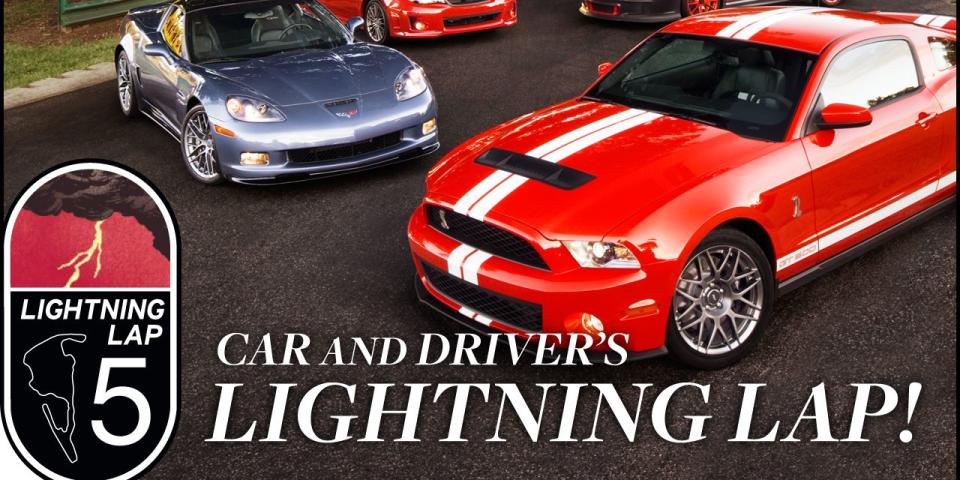
Our Lightning Lap tests seeks to find the best outright combination of power, handling, roadholding, and braking offered by the latest hot performance cars. In an ideal world, we'd love to drive these cars on a public road, but running machines such as these at their limit on the highway presents practical problems—things like other drivers, speed limits, and roadside hazards.
Our simple solution nearly five years ago was to look for the track in North America that best approximates a challenging road, with a variety of corners, long straightaways, and plenty of elevation changes. A track meeting this description would allow us to assess all-around performance, expressed in lap times, in a controlled and relatively safe environment. The track we chose is the Grand West Course at Virginia International Raceway (VIR), near Danville, a serpentine 4.1-mile circuit that is the nearest the U.S. has to the ultimate racetrack, the Nürburgring Nordschleife in Germany. Automakers from around the world converge on the 'Ring for the development of their vehicles, particularly high-performance models; domestic manufacturers also incorporate VIR in their vehicles' testing programs.
Unlike our "Best-Handling Car in America" test [October 2010], where we used the Waterford Hills road course in Michigan as an element of the selection process, we rank finishers in Lightning Lap strictly on lap times, based on the best run achieved by each car during our two-day event (without any subjective criteria). Handling prowess is important for extracting a good lap time at VIR, but brakes and power are even more significant here, which isn't the case on the tight Waterford Hills track.
The 20 new or revised performance cars we gathered for our fifth edition of Lightning Lap are sorted by base price (which includes performance-enhancing options) into five classes.
We didn't bring any non-street-legal cars to the party this time, so there is no LLU (Unclassified) segment.
As ever, there were some real surprises among the vehicles gathered, although nothing beat the outright record of 2:45.9 set by the Mosler MT900S, or the Dodge Viper SRT10 ACR's 2:48.6, both of which occurred during our third Lightning Lap in 2008. These two cars are, however, hardly built for the street.
The pace has certainly picked up since our inaugural event in 2006, wherein no vehicle beat the magical three-minute mark. In 2007, two cars scraped below three minutes. In 2008, five cars blitzed that mark. In both 2010 and 2011, six machines beat the figure, which is what happens when you're in the middle of the fiercest horsepower war the auto industry has ever fought.
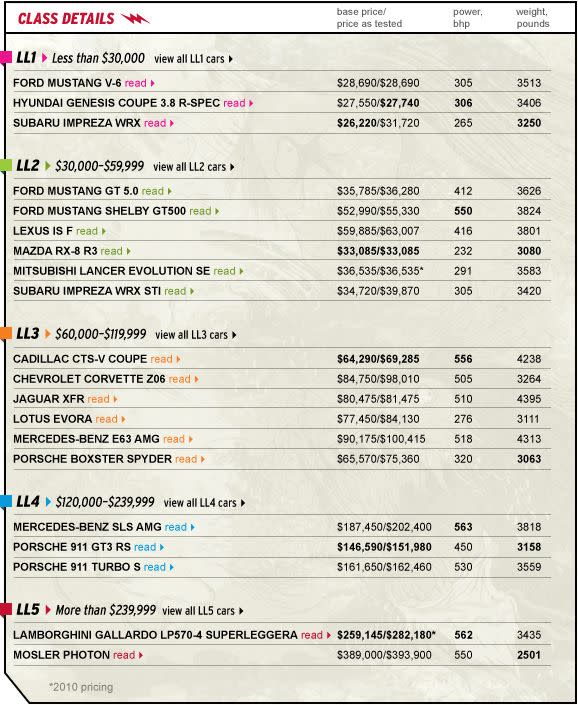
_____________________________________________________

LL2 ($30,000–$59,999)
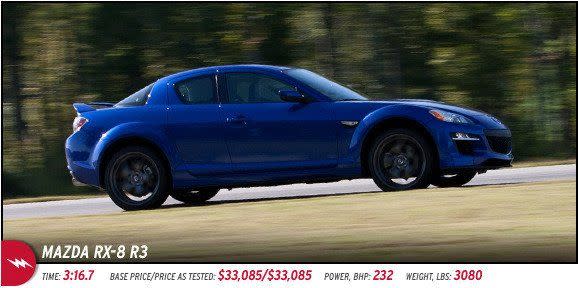
We invited Mazda’s rotary-powered RX-8 back to see if the R3 package would help shave any time from the 3:19.0 lap we recorded in 2006. Said R3 package brings Bilstein shocks, lightweight 19-inch forged wheels, Bridgestone RE050A tires, and marginally wider front and rear tracks. Inside, the standard seats swap places with form-fitting Recaro buckets. In the interest of saving weight, there’s no sunroof available.
The 1.3-liter rotary engine remains untouched in the R3; with only 232 horsepower and 159 pound-feet of torque, there’s little more than a light pat on the back as you roll onto the throttle to exit a corner. A quick lap in the RX-8 requires careful preservation of every last bit of speed, but the sharp steering and easy-to-exploit grip allow the RX-8 to be flung into corners without fear. Brake too hard, and the rotary will fall out of its power band, weakly pulling itself from the corner. That rarely was a problem, though, as brake fade and a soft pedal (compared with the Boxster Spyder and the Evora) made erasing too much speed unlikely.
Cornering in the R3 is a remarkably neutral affair, and the relatively long, sedan-like 106.3-inch wheelbase helps keep movements stable. Lifting the throttle will swing the rear end sideways, but the rear tires break loose gradually enough that they’re easy to catch. The view out of the windshield is IMAX expansive, and the tops of the fenders are clearly visible, which makes placing the car on the track a snap. You get the feeling that the RX-8 won’t do anything too surprising too quickly—and, until it gets more power, it never will.
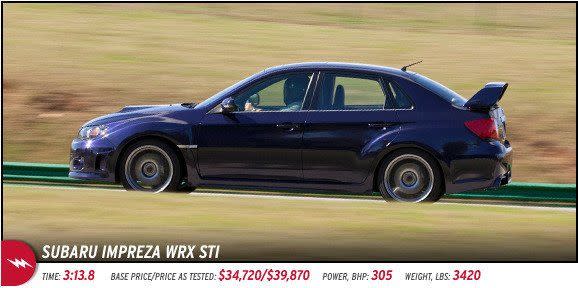
Compared with its non-STI little brother, the WRX STI is slower down the front straight—122.0 mph to the WRX’s 123.4—and has less lateral grip in Turn One, posting 0.84 g versus 0.89. And while it’s not the broom that the base WRX turned out to be, it does push through corners. So why does the STI, at 3:13.8, lap VIR 2.7 seconds faster than the WRX? The lead occurs mainly through the winding sections of the track, where the STI’s tighter chassis and fade-free brakes mean drivers can solve handling dilemmas instantaneously and carry more speed with less body roll.
Unlike the WRX, the STI’s brake pedal didn’t throw a tantrum and drop to the floor. It returned excellent feel and control and kept the brakes on the good side of ABS intervention for optimal speed reduction.
As with its WRX sibling, understeer is the STI’s dominant chassis trait, despite the STI’s trick center differential that automatically sends torque to the axle that can use it best. The center-diff control lets the driver add additional yaw via the throttle if so desired, but this does nothing to help the STI’s semi-vague turn-in. The shifter does not like to be hurried; when a shift is rushed, the clutch reengagement sends a shuddering thud (thuddering shud?) through the car. While the STI is a better track toy than the WRX, the stopwatch favors Mitsubishi’s STI-fighting Evo.
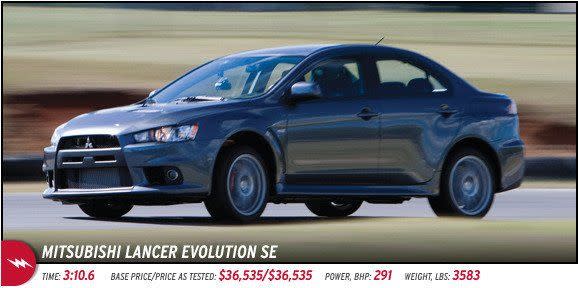
In the arena of four-wheel-drive pocket rockets, there is one fight that seemingly won’t die: STI versus Evo. We have always said that the Evo comes into its own on the track, and the SE variant—all the MR Edition’s go-fast bits without the added weight of cosmetic bolt-ons—puts an exclamation point on that statement.
The SE’s 3:10.6-second lap is 3.2 seconds quicker than the STI’s. It’s fleeter than the STI through all sectors but the second—where it’s a dead heat—and it’s faster down the front straight (124.2 mph versus 122.0). The Evo also has better sightlines over the dash, which helps you place it on track. Both cars exhibit the kind of understeer a big-rig driver might find comforting, but the Evo has slightly sharper turn-in. Whereas the STI continues to plow through a corner, the Evo’s torque-vectoring wizardry one-ups the STI as it can split torque side-to-side—not just fore-and-aft—and produce magical results. Trail brake or use the throttle; either way, the Evo will rotate progressively, the hallmark of a fine chassis.
Another clear advantage is the Evo’s dual-clutch automated manual. It allows for effective left-foot braking, shaving fractions of a second during every brake application, and denies any chance of mismatched revs on a downshift. Resident Evo lobbyist Michael Austin claimed that the car would be quicker if the transmission were left in automatic mode. Skeptical, we humored him. Much to our chagrin, it was quicker. Flicked to S-Sport, the tranny shifts exactly on the redline and downshifts just as we would. It’s almost telepathic. Austin’s subsequent gloating was short-lived but well deserved. The Evo is the pocket-rocket champ at VIR.

The Mustang GT gives you the best parts of the V-6–powered car, only with more ponies. Its 412-hp V-8 is 107 horses stronger than the 113-pound-lighter V-6 model, and it’s 138 horses short of the 198-pound-heavier, V-8–powered Shelby GT500. The GT’s additional juice, without a correspondingly significant weight penalty, is a key reason why we singled it out for this year’s 10Best Cars award and why it performs so well on a track. It is worth noting, though, that a mandatory option for hot lapping is the $1695 Brembo front brake package, which also brings sticky Pirelli P Zero tires. With that package, the GT turns a 3:08.6 lap, 0.9 second quicker than its longtime pony-car rival, the Camaro SS, managed in last year’s Lightning Lap, and third in class despite being the second-least-expensive LL2 car, at $36,280.
Like the V-6, the GT’s steering is above average. Turn-in is crisp, handling near neutral, and controlled trail braking is possible. The GT’s shifter—unlike the GT500’s—is never too quick, never induces grinding, and is light enough in hand that missing a shift is a rare event. The GT exhibits a little more body roll than the GT500, which makes the side-to-side-in-your-seat banging around less intense and more tolerable. Still, the GT would benefit greatly from a more heavily bolstered seat.
Sector two is the only place where the GT outperforms the GT500. The GT requires few throttle changes, and carrying speed is easier because the Shelby requires a significant lift to stay on track. Is it the ’80s again? Because the 5.0-liter is, once again, cool as ice. Vanilla Ice.
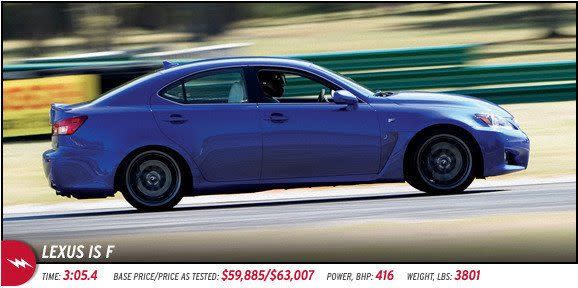
Three years back, an IS F turned a less-than-impressive 3:14.0. We said then, “A little attention to springs and damping might make this eager contender a real champ,” as the stiffly sprung F zapped confidence in high-speed corners.
Boy, were we right. Lexus has since tweaked all suspension elements. Spring rates are down in the front and up in the rear, and there are larger anti-roll bars, stiffer subframe bushings, and longer bump stops, which effectively increase spring rates when the car is nearing its maximum roll angle. Lexus also lightened the front hubs and control arms and slapped a Torsen limited-slip differential in the rear axle. The result is BMW M3–matching performance around VIR (3:05.4). That’s heady company for Lexus to be keeping. Especially considering that the IS F weighs 3801 pounds (195 more than the M3) and makes only two additional horsepower, at 416.
Lexus also redesigned the gauges, enlarging the tachometer and relocating it to the center of the instrument binnacle. But it could have removed the thing altogether because we did not so much as peep at it: The IS F’s audible shift warning is plenty loud, even when you are wearing a helmet. While the alert is slightly obnoxious on public roads, it lets you keep your eyes up when driving on a track.
The old F rolled around on the track like a keel-less boat in gusting winds. The aforementioned updates quell this tendency and increase confidence. Our backside impressions are supported by numbers: The F exits sector two 13.1 mph quicker than before, at 109.1. Steering is communicative, and the chassis is set up for safe, moderate understeer, but vector adjustment is just a throttle tweak away—the torquey engine (371 pound-feet) can break the rear tires loose easily. The brakes are fantastic, too. The pedal might be a tad wooden (more pliant pine than hard oak), but the system remains fade-free after multiple laps of abuse, something none of the other large sedans could claim this year. The 180-degree character change performed by this Lexus gives us hope that Toyota can still make fun-to-drive cars. Now where’s our Supra?
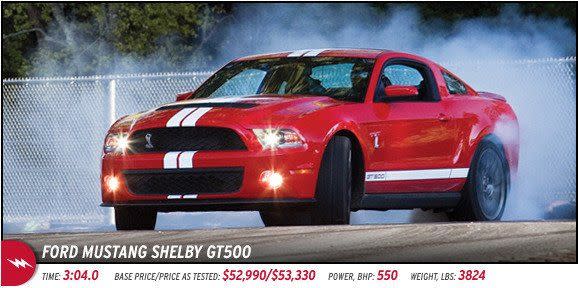
Shelby GT500s have never fared well in this test. The old iron-block engine repeatedly suffered from heat soak—sapping power—and the car’s tires wouldn’t last more than one lap. The 2011 updates—including a retuned suspension, new tires, an aluminum engine block, and a more efficient intercooler—have paid major dividends here, lopping nearly two seconds from the GT500’s 2007 record of 3:05.9. At 3824 pounds, the 2011 car is also lighter than that one by 84. It’s still a portly beast, but it handles like a coupe that is closer to the 3500-pound mark. There is some body roll but not a lot. And despite its solid rear axle, the GT500 brews confidence by the gallon. It excels in sectors three and five, where it keeps pace with pricier LL4 participants. If the seats did a better job of keeping the upper and lower body in place, times in sectors two and four would shrink drastically. A certain amount of steering-wheel control is sacrificed when your arms have to work harder to keep you in place than the seat does.
Even a racing bucket and a five-point belt wouldn’t bring out the absolute best in the GT500. A perfect lap requires repeatability. The shifter’s throws, for one, are unnecessarily short, and getting a lap together with an error-free two-to-three shift didn’t happen. Also, the 550-hp V-8 revs quickly to its 6250-rpm redline. At the right-hander leading into the “Snake,” the GT500 is, if driven correctly, right on its rev limiter at the apex. Managing a midcorner upshift while maintaining directional control is tough to pull off.





With its sleek shape and gizmo-laden interior, a Jag XF—even the more powerful and formidable XFR model—turning hot laps might at first seem akin to Kim Kardashian competing in the Ironman. But the XFR is actually quite well sorted. It’s forgiving, planted, and totally okay with being chucked over curbing through the esses, where the $80K sedan averaged a solid 111 mph—same as the $200K Mercedes SLS AMG.
But the Jag is a little soft and reluctant to turn in—and oversteer is pretty much out of the question—which led to well-below-average grip of 0.89 g through Turn One. And the Jag turned the second-worst time this year through sector three. The seats are a bit lacking, too, with power-adjustable torso bolsters that don’t extend far enough to be useful.
Although the XFR’s supercharged V-8 makes a compelling 510 horsepower, with strong midrange torque to help accelerate out of corners, the engine is a bit quiet in a track environment, so you need to consistently monitor the tach in order to grab timely manumatic shifts.
In a three-way comparison test with the Mercedes E63 AMG and Cadillac CTS-V, the Jag XFR finished third. Although it is quick and competent, and its brakes held up better than the Benz’s at VIR, that’s exactly where the XF’s lap time landed among the same group here.

The Evora is the first Lotus in a very long time that is at home on public roads. So, has maturity cost it the track playfulness we’ve come to expect from Colin Chapman’s brand? Not a chance. Despite the addition of power steering and a curb weight that’s 1100-plus more pounds than an Elise, the Evora talks and walks like a race car.
It’s obvious by the first corner after the long straight that the Evora’s bloodline traces back to the Lotus 7. Stomping hard on the brakes from a peak speed of 128.7 mph reveals a firm, responsive, and Porsche-like brake pedal; the Evora never seems to overstress its brakes or tires. Once slowed, the Evora’s nose dives into Turn One and sticks to the pavement at an astonishingly useful 0.95 g. We hesitate to call anything perfect, but the Evora’s steering feel and feedback were judged to be the best of the cars invited this year. Refreshingly light, the steering weights up as the tires’ loads increase, until the rubber begins to slip and the effort begins to disappear.
Exiting that first corner exposes the Lotus’s major weakness—its shifter. Moving quickly from second to third gear requires luck, concentration, and time. In contrast to the Boxster Spyder, the Evora’s 276 horses leave you wanting for more thrust on corner exits and on the straights; the 345-hp Evora S cannot arrive soon enough. High-speed left-to-right transitions expose some confidence-sapping rear-end nervousness. This helps to explain the Evora’s low entry speed into the uphill esses of sector two and its unimpressive 63.8-mph speed out of the esses that precede sector four. That twitchiness commands respect, just like a race car.
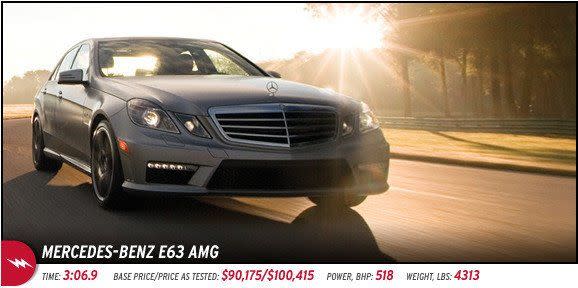
A good start: Initial laps in the E63 revealed more bite on turn-in and higher overall grip than either the XFR or the CTS-V. The data, which showed the Benz clinging to Turn One with 0.93 g and a CTS-V–beating sector-five time, supported this impression.
However, the bigger, heavier Benz doesn’t corner as fluidly as the Caddy. It wallows through the challenging uphill esses, which made the Benz feel like the heaviest of the luxury-rocket trio even though the Jag outweighs it by 82 pounds. And although the big-displacement AMG has no shortage of firepower—with glorious waves of sound cascading behind—it couldn’t keep up with the CTS-V down the straightaways.
As in the Jag, we found ourselves in a gearbox pickle: Upshifts are best accomplished in automatic mode, but even the sportiest settings don’t downshift aggressively enough, and this wastes precious tenths when accelerating out of corners. So we stuck with manual mode—abetted by large, easy-to-use paddles on either side of the steering wheel—even though the small tach makes it tough to time upshifts. And the transmission sometimes ignored our downshift commands. All of which makes the CTS-V’s manual option look even sweeter.
But the Benz earns its biggest demerit in the braking department. Within a single lap, the satisfyingly firm pedal starts sinking toward the floor. The anchors never gave out, but that mushy feeling made it tough to select braking points with any confidence.
Although it’s more than two and a half seconds behind the CTS, the E63 is certainly no slouch. Surprisingly, it was just 0.4 second slower than its little-brother C63, which has a slightly lower-tuned version of the E’s powertrain but is 324 pounds lighter. And this roomy, five-seat sedan is only 1.1 seconds off the pace of a Porsche 911 Carrera S.
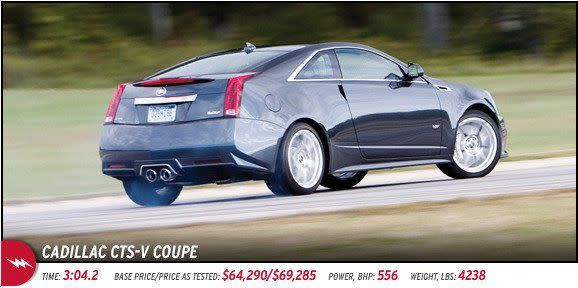
The CTS-V hunkers down like a 1000-pound-heavier, far-more-luxurious Corvette, and it shares the Chevy’s distinction as a production car truly deserving of the vastly overused “track ready” descriptor. Particularly notable are the CTS-V’s brakes, which didn’t flinch during repeated use from almost 144 mph for Turn One, unlike the other two-ton-plus competitors, the Mercedes E63 and the Jag XFR.
This coupe turned essentially the same lap time as the sedan we tested in 2008—not entirely surprising considering that the coupe is a mere 31 pounds lighter. That weight is one of the only things holding back the super-Caddy; there’s no getting around its substantial 4238 pounds. In the tighter sections, the CTS-V’s performance was below average, trailing that of some less powerful but lighter, cheaper contenders.
Working to overcome that deficit is an abundance of supercharged thrust, and the Caddy puts down everything it has when hurling itself out of corners. But it’s far more than just an accelerative hero. When applying power on corner exit, the rear end is exceptionally balanced and, if provoked, will come around predictably. Trail braking into a turn also gets an obedient rear-end response. Plus, the pedals are set up for easy heel-and-toe downshifts.
Mostly, though, one less-than-satisfactory element stood out: the Recaro seats. They have decent support, but they rocked back and forth annoyingly in their mounts. Also, the throws of the manual shifter could be shorter.
Although the CTS-V is eminently satisfying on track, this level of fortitude can’t be cheap. Which makes us wonder if customers wouldn’t readily trade, say, two seconds of lap time at VIR—it’d still be quicker than an E63—for better seats and a richer interior.
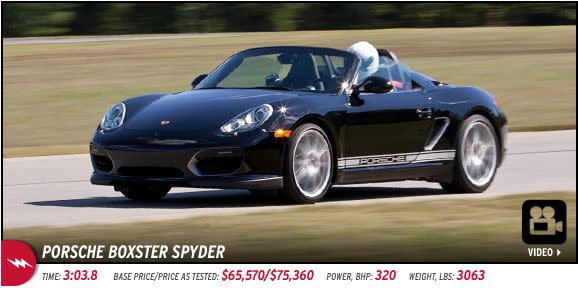
It might have won our most recent best-handling-car test, but how would the Boxster Spyder cope with the Bosque Hades that is VIR? Turns out VIR wasn’t too terrifying a place for the Spyder as it posted a time of 3:03.8, two seconds quicker than the Cayman S we tested last year. Lighter than the Cayman S by 102 pounds (we mention the Cayman because this is the first Boxster we’ve invited to Lightning Lap), the Spyder’s lowered suspension, chassis tweaks, and grip make it feel lighter than its 3063 pounds. The open car doesn’t have more power than the Cayman S, but the Spyder’s modifications do impart a reassuringly steady stream of clear, detailed information that allows the driver to make informed decisions about how to react to the car’s behavior.
Lucid, reliable communication about the onset of tire slip, changes in pavement texture, load transfer, engine power, and grip under braking flows through the controls and the racing-style bucket. The Spyder’s seat may lack a lot of adjustability, but it hugs so securely that you feel like a part of the Spyder’s nerve center. When the time comes to act, the car responds instantly. Balancing understeer and oversteer through the long off-camber right- and left-handers of sector four is a satisfying ballet of incoming information and driver reaction. Steering weight increases progressively as the tires approach their limit and drops off when they exceed it. Throttle movements relay to the chassis instantaneously, and the load shifts that occur through the esses seem to happen in fluid slow motion. The dual-clutch gearbox shifts so quickly that power seems uninterrupted; downshifts arrive as soon as you tap the paddle or shift lever. Unlike the Spyder in the handling test, the car at VIR exhibited no brake fade and maintained solid and reassuring brake-pedal feel throughout its lapping sessions.
A look at the individual sector results reveals just a few ticks stolen here and there, but add enough fractions, and pretty soon you have a two-second advantage over the Cayman S. A better power-to-weight ratio plays a part in the lap-time reduction, but we’d chalk up most of the Spyder’s improvement to its ability to provide better information, and better information plays a major role in better lap times.
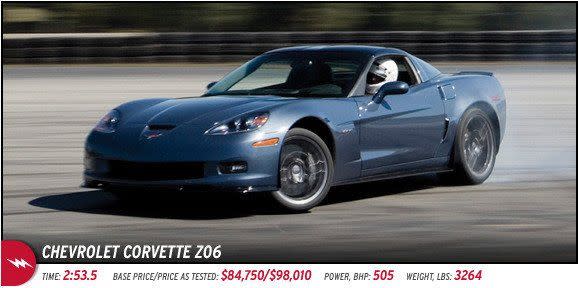
The Corvette Z06 now offers a Z07 performance package that incorporates some of the best features from the top-of-the-line ZR1, namely magnetorheological shocks, Michelin Pilot Sport PS2 tires, and Brembo carbon-ceramic brakes. Our tester also came with a carbon-fiber trim package.
Thus equipped, the Z06 strays awfully close to a $100,000 sticker price. But the Z07 option makes the Z06 blossom into a frankly amazing track car. Although it cedes 133 horsepower to the supercharged ZR1, the Z06 was just 1.7 seconds off the pace of its more expensive sibling. Through the various zones we highlight on VIR, the Z06 was only slower than the ZR1 in the first sector, equal to it in sectors two and five, and faster in sectors three and four. The latter two are handling areas where the Z06’s 115-pound weight advantage comes into play; both cars have the same wheel-and-tire package so that factor doesn’t affect the results.
The Z06 Corvette was 5.3 seconds quicker than the Grand Sport from our last Lightning Lap and shaved 4.7 seconds off the Z06’s time from the 2007 event. It was also quicker than the Lamborghini Murciélago LP670-4 SV we ran last year and the breathtaking Ferrari 430 Scuderia at VIR in 2008, cars that are vastly more expensive. And the Vette felt as if it could run fast, repeatable laps all day long.
At VIR, the Michelins certainly grant the Z06 more fluid handling than the Goodyear Eagle F1 Supercar EMT tires that are standard Z06 issue. They relinquish grip more progressively, but the snarling 7.0-liter V-8 still has more than enough torque to pitch the car sideways. We were also impressed by the car’s relatively neutral midcorner behavior and its brakes, which could stop a runaway locomotive. Say it with us now: If only the seats were more supportive and the shifter a little more cooperative.




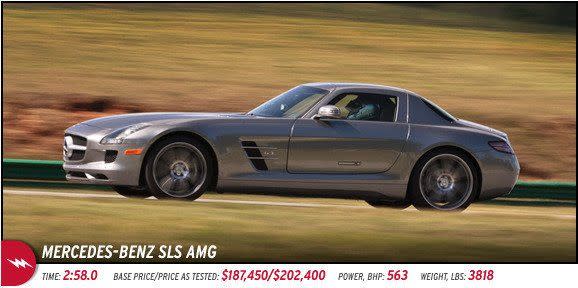
Okay, we’ll admit it: Our lap in the SLS was hardly perfect. We lost speed in the uphill esses because the Benz felt squirrelly through there on its first hot lap, but by the time we felt more confident in its behavior on the next round, the tires had lost their edge and the car’s performance dropped off. Still, its time was a good 1.5 seconds faster than the Audi R8 5.2 FSI’s that we praised to the heavens last year.
The SLS is thrillingly fast, hitting 153.1 mph down VIR’s long front straightaway. It has stout brakes and handles in a playful, oversteering manner if you switch off the stability control. It is big fun around VIR and won’t bite you, but the steering seems a touch bored by what the tires are saying. The SLS also felt heavy—witness its 3818-pound weight—and didn’t transition well from side to side in turns. That was demonstrated by its speed through both sector two (the esses) and sector four, an area that combines one turn after another and demands a chassis that is hyperfluent and responsive.
The 6.2-liter V-8 is one of the wonders of the automotive world, powerful and sonorous. But the gear ratios on the seven-speed dual-clutch transmission are too short for track work; we found ourselves in between gears on several occasions. The gearbox is also slow to respond to up- and downshifts when used manually. Finally, our designated driver didn’t fit that well, finding that the lateral bolsters on the seats interfered with his elbows while twirling the wheel. But, man, what a car.
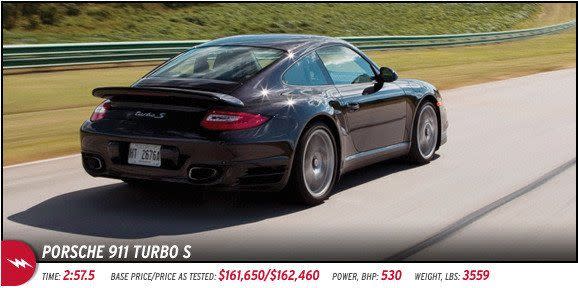
The 911 Turbo S isn’t one of Porsche’s hard-core track devices, but it shadowed the non-street-legal Ariel Atom 3 from 2010 by 0.1 second. It also shaved more than eight seconds off the last 911 Turbo’s time, set in 2007 in a non-S. The current Turbo S has an additional 50 horsepower from a new direct-injection flat-six, which certainly helps, but other changes wrought for the 2010 model year—the seven-speed dual-clutch PDK transmission, a revised suspension and all-wheel-drive system—have also made this new Turbo a far better track lapper.
The Turbo S doesn’t boast about its on-track prowess, whistling and whooshing like a low-flying fighter plane. It makes good use of the all-wheel-drive system’s traction as well as its aching turbo thrust to squirt rapidly between corners, hitting 155.4 mph at the end of the main straightaway. The car’s power, its feedback-intensive steering, and its stellar braking performance—matched by delicious pedal feel—made up for its slightly soft demeanor through the corners.
Not that the Turbo S did anything poorly, but it did lack the precision of the 911 GT3 RS. This was reflected in decent but unspectacular sector times: There was more body roll, less communication between car and driver, and more understeer in the Turbo S than in the RS. Despite all the power, it took a lot of effort to rotate the car midcorner, which particularly hurt its time in sector three, and the Turbo S didn’t like being trail-braked into bends. But, for a car that is so easy to live with every day, 2:57.5 is a shockingly good lap time.
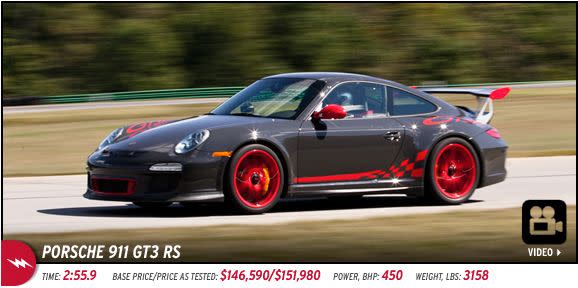
Everyone agreed: The 911 GT3 RS might not have been the fastest car in this particular Lightning Lap event, but it was the sweetest to drive. It starts flattering its driver in the cabin, which is tailored to the serious pilot like no other car here. The bucket seat wraps intimately around your torso, the Alcantara-trimmed shifter has flick-o’-the wrist short throws, and the steering wheel’s rim is just the right thickness.
The 450-hp GT3 RS was fast but got stomped in a straight line by the Corvette Z06 and the LP570-4 Superleggera, both of which kill it in power to weight: The Z06 and the Lambo have 6.5 and 6.1 pounds per horsepower, respectively, versus the Porsche’s 7.0. Going into the uphill esses, the RS was 2.8 mph off the Corvette’s pace and 6.3 mph slower than the Lambo, and it’s difficult to claw that gap back through those corners.
Just like the GT3 we tested in 2007, the true joy of the RS lies in its responses. The engine wails like a race car at the top end; the steering is talkative and perfectly weighted; the brake pedal responds instantly and is a model of linearity; and the car’s slip angle is directly proportional to the incline of the driver’s right foot. Like the Corvette, the GT3 RS wanted us to rag on it all day; unlike the Corvette, it felt small and nimble and barely rolled, dove, or squatted under duress.
All the GT3 RS needs is another 150 horsepower to mount a serious challenge to the ZR1’s and Superleggera’s times. Hang on, Porsche has the answer: It’s called the 911 GT2 RS, and it actually has 170 more horses.




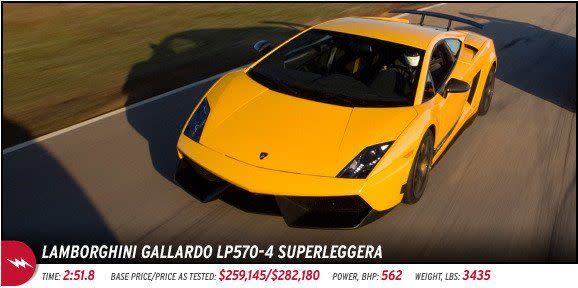
The LP570-4 Superleggera sheds weight and adds power in its quest for on-track dominance. More specifically, it gets 10 extra horsepower—up to 562—and loses 72 pounds compared with the LP560-4 we tested in 2009. The suspension gets a dramatically stiffer tune, too. While the interior is stylish, the carbon-fiber bucket seats were too wide for our skinnier drivers, and there wasn’t enough headroom in the cabin for taller ones.
This Lamborghini was one of the surprise performers of the test. It equaled the Corvette ZR1’s time and took 2.1 seconds off the more powerful Murciélago LP670-4 SV’s, despite having a power-to-weight ratio that’s inferior to both of those cars’ (this Gallardo has 6.1 pounds per horsepower compared with 5.8 for the Murciélago and 5.3 for the ZR1). Yet the Superleggera was even faster in a straight line than either the ZR1 or the LP670-4, hitting 159.2 mph into Turn One versus 157.5 for the bigger Lambo and 157.4 for the king Chevy.
The secret to the baby Lambo’s success is a combination of amazing traction, balanced handling, and well-spaced gear ratios. The V-10 engine matches the GT3’s for aural excitement and breadth of power band, zinging up to 8000 rpm with the enthusiasm of a puppy chasing a toddler. The car isn’t as tactile as the Porsche, but it is not without its charms. The Superleggera’s mighty brakes are a touch grabby at first and don’t have the Porsche’s reassuring feedback,and its steering isn’t as communicative, either. But the Lambo’s chassis is remarkably neutral in most circumstances, even if it still allows you to kick out the tail in second-gear corners under power.
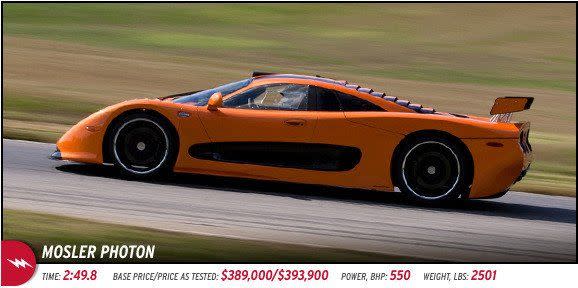
Most cars come with a factory warranty, but the Mosler seemingly came with its own factory of handlers. And it needed it, too, due to several mechanical issues. The Photon is an evolution of the MT900S. It has the same mildly tuned 550-hp, mid-mounted Corvette LS7 engine, now hooked up to an exotic sequential six-speed Hewland transmission. This and other changes cut 83 pounds from the Mosler’s weight. Mosler also reduced the rear track by 1.2 inches and fitted narrower 315-section tires in place of 345s.
Mosler thought the new car would be quicker than the MT900S, but we couldn’t better 2:49.8, which is nearly four seconds slower than the 900S’s staggering pace. The Photon showed the benefits of a slightly better power-to-weight ratio and slipperier aerodynamics in a straight line, reaching 161.1 mph before Turn One (7.2 mph faster) and arriving at the uphill esses with 2.5 more mph. The new Mosler also recorded the first sub-8.0-second time throughout the esses (sector two) but was slower than the MT900S everywhere else.
There were a number of factors that contributed to the Photon’s disappointing performance. First, because of problems on day one, we set our fast time on the second afternoon, when warmer temperatures weren’t conducive to great laps. Our confidence was shaken by the transmission’s predilection for choosing gears at random, resulting in a vicious 120-mph spin in the esses when the car grabbed third rather than fourth on a downshift. With the narrower rear tires, the car just wouldn’t put the power down out of tighter corners and responded poorly to trail braking. And finally, possibly because of a burned shifter cable, the Hewland took about 0.4 second to shift from fourth to fifth, which translated to 3 to 4 mph of lost speed on both straights. So it’s still the winner of this edition of Lightning Lap, but we bet the guys at Mosler aren’t satisfied.


We’ve run Lightning Lap five times now, amassing a ton of blistering lap times around VIR. You can see them all in the table below, which can be sorted by time, vehicle, and Lightning Lap class. Click the Time, Car, and Class headers to sort by each parameter.
Rank | Issue Date | |||
|---|---|---|---|---|

You Might Also Like

 Yahoo Autos
Yahoo Autos 